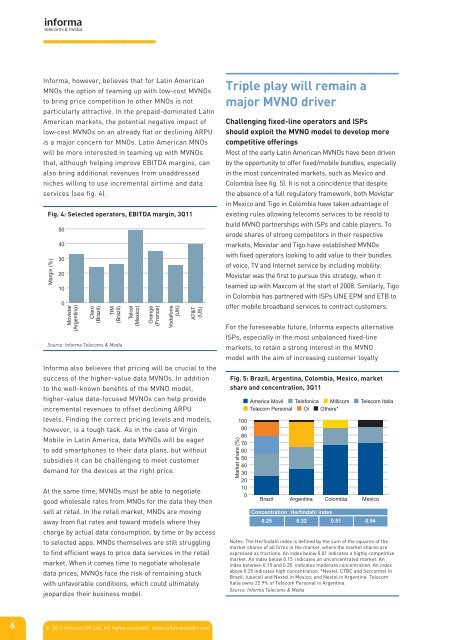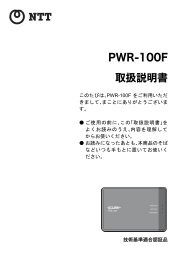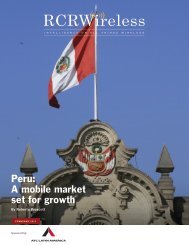You also want an ePaper? Increase the reach of your titles
YUMPU automatically turns print PDFs into web optimized ePapers that Google loves.
Informa, however, believes that for Latin American<br />
MNOs the option <strong>of</strong> teaming up with low-cost <strong><strong>MVNO</strong>s</strong><br />
to bring price competition to other MNOs is not<br />
particularly attractive. In the prepaid-dominated Latin<br />
American markets, the potential negative impact <strong>of</strong><br />
low-cost <strong><strong>MVNO</strong>s</strong> on an already flat or declining ARPU<br />
is a major concern for MNOs. Latin American MNOs<br />
will be more interested in teaming up with <strong><strong>MVNO</strong>s</strong><br />
that, although helping improve EBITDA margins, can<br />
also bring additional revenues from unaddressed<br />
niches willing to use incremental airtime and data<br />
services (see fig. 4).<br />
Fig. 4: Selected operators, EBITDA margin, 3Q11<br />
Margin (%)<br />
50<br />
40<br />
30<br />
20<br />
10<br />
0<br />
Movistar<br />
(Argentina)<br />
Claro<br />
(Brazil)<br />
TIM<br />
(Brazil)<br />
Source: Informa Telecoms & Media<br />
Telcel<br />
(Mexico)<br />
Informa also believes that pricing will be crucial to the<br />
success <strong>of</strong> the higher-value data <strong><strong>MVNO</strong>s</strong>. In addition<br />
to the well-known benefits <strong>of</strong> the <strong>MVNO</strong> model,<br />
higher-value data-focused <strong><strong>MVNO</strong>s</strong> can help provide<br />
incremental revenues to <strong>of</strong>fset declining ARPU<br />
levels. Finding the correct pricing levels and models,<br />
however, is a tough task. As in the case <strong>of</strong> Virgin<br />
Mobile in Latin America, data <strong><strong>MVNO</strong>s</strong> will be eager<br />
to add smartphones to their data plans, but without<br />
subsidies it can be challenging to meet customer<br />
demand for the devices at the right price.<br />
At the same time, <strong><strong>MVNO</strong>s</strong> must be able to negotiate<br />
good wholesale rates from MNOs for the data they then<br />
sell at retail. In the retail market, MNOs are moving<br />
away from flat rates and toward models where they<br />
charge by actual data consumption, by time or by access<br />
to selected apps. MNOs themselves are still struggling<br />
to find efficient ways to price data services in the retail<br />
market. When it comes time to negotiate wholesale<br />
data prices, <strong><strong>MVNO</strong>s</strong> face the risk <strong>of</strong> remaining stuck<br />
with unfavorable conditions, which could ultimately<br />
jeopardize their business model.<br />
Orange<br />
(France)<br />
Vodafone<br />
(UK)<br />
AT&T<br />
(US)<br />
Triple play will remain a<br />
major <strong>MVNO</strong> driver<br />
Challenging fixed-line operators and ISPs<br />
should exploit the <strong>MVNO</strong> model to develop more<br />
competitive <strong>of</strong>ferings<br />
Most <strong>of</strong> the early Latin American <strong><strong>MVNO</strong>s</strong> have been driven<br />
by the opportunity to <strong>of</strong>fer fixed/mobile bundles, especially<br />
in the most concentrated markets, such as Mexico and<br />
Colombia (see fig. 5). It is not a coincidence that despite<br />
the absence <strong>of</strong> a full regulatory framework, both Movistar<br />
in Mexico and Tigo in Colombia have taken advantage <strong>of</strong><br />
existing rules allowing telecoms services to be resold to<br />
build <strong>MVNO</strong> partnerships with ISPs and cable players. To<br />
erode shares <strong>of</strong> strong competitors in their respective<br />
markets, Movistar and Tigo have established <strong><strong>MVNO</strong>s</strong><br />
with fixed operators looking to add value to their bundles<br />
<strong>of</strong> voice, TV and Internet service by including mobility.<br />
Movistar was the first to pursue this strategy, when it<br />
teamed up with Maxcom at the start <strong>of</strong> 2008. Similarly, Tigo<br />
in Colombia has partnered with ISPs UNE EPM and ETB to<br />
<strong>of</strong>fer mobile broadband services to contract customers.<br />
For the foreseeable future, Informa expects alternative<br />
ISPs, especially in the most unbalanced fixed-line<br />
markets, to retain a strong interest in the <strong>MVNO</strong><br />
model with the aim <strong>of</strong> increasing customer loyalty<br />
Fig. 5: Brazil, Argentina, Colombia, Mexico, market<br />
share and concentration, 3Q11<br />
100<br />
90<br />
80<br />
70<br />
60<br />
50<br />
40<br />
30<br />
20<br />
10<br />
0<br />
Market share (%)<br />
America Movil Telefonica Millicom Telecom Italia<br />
Telecom Personal Oi Others*<br />
Brazil<br />
Argentina<br />
Concentration: Herfindahl index<br />
Colombia<br />
Mexico<br />
0.25 0.32 0.51 0.54<br />
Notes: <strong>The</strong> Herfindahl index is defined by the sum <strong>of</strong> the squares <strong>of</strong> the<br />
market shares <strong>of</strong> all firms in the market, where the market shares are<br />
expressed as fractions. An index below 0.01 indicates a highly competitive<br />
market. An index below 0.15 indicates an unconcentrated market. An<br />
index between 0.15 and 0.25 indicates moderate concentration. An index<br />
above 0.25 indicates high concentration. *Nextel, CTBC and Sercomtel In<br />
Brazil; Iusacell and Nextel in Mexico; and Nextel in Argentina. Telecom<br />
Italia owns 22.9% <strong>of</strong> Telecom Personal in Argentina.<br />
Source: Informa Telecoms & Media<br />
6<br />
© 2012 Informa UK Ltd. All rights reserved. www.informatandm.com
















